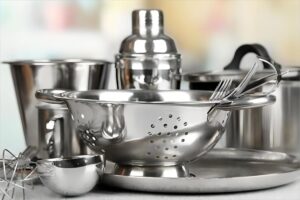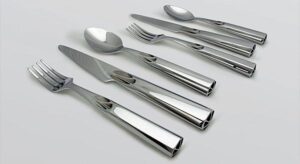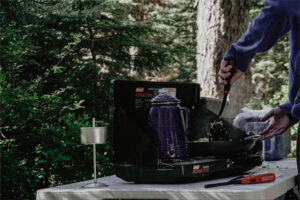
Fortunately, the longevity of stainless steel allows almost any sort of utensil to be used on the cookware, but we want to provide you with the finest of the best in terms of alternatives.
Why Can’t You Use Any Type of Utensil on Your Stainless Steel?
We mentioned that almost all utensils for use with stainless steel cookware will work, but some will not be owing to how the various metals and materials react with one another. For example, any aluminum cooking utensils will not work since the mixture of metals would result in galvanic corrosion, which is the movement of electrons from one substance to another.
In the case of stainless-steel cookware and aluminum utensils, the transfer of electrons from aluminum to stainless steel reduces the shelf life of the aluminum utensils while increasing the shelf life of the stainless steel. In other circumstances, some tools perform perfectly with stainless steel but are unsuitable to use for other reasons. For example, while bamboo utensils are made from renewable materials and are quite durable, they must be hand-washed to avoid absorbing excessive moisture. They also need to be lubricated regularly to keep them from getting dry and brittle. So, while bamboo utensils may be used with stainless steel, they require some care.
What Utensils to Use with Stainless Steel Cookware?
Metal
Metal utensils come in a variety of styles, with aluminum and stainless steel being the most popular materials. Many of us grew up believing that metal utensils cannot be used in pans, but this is especially true for non-stick-coated pans since the metal spoon will scratch off the coating.
That isn’t to suggest that metal spoons won’t damage stainless steel cookware. They most likely will, but the scratch will be superficial and have no effect on the pan’s usage. There are several reasons that I prefer stainless steel cutlery over other metals. Stainless steel is “non-reactive,” which means it may be used to prepare any type of food. Materials like aluminum are reactive. This means that when aluminum comes into contact with acidic foods, the metal will leach into the food. Uncoated copper produces the same result.
Stainless steel is also highly durable, rust-resistant, and dishwasher-safe. Stainless steel utensils are also heat resistant, which means they will not burn or melt when exposed to high temperatures. Additionally, stainless steel retains heat longer than aluminum. It is also generally more costly than other materials.
Wood
Using wooden tools on stainless steel is completely acceptable, especially because wooden utensils are one of the most popular choices among home chefs in their kitchens. They are resistant to germs and bacteria and are extremely ecologically friendly. Plus, while cooking using high-heat pans, they seldom become too hot!
The NAYAHOSE Wooden Cooking Utensil Set is ideal for use with stainless steel equipment. This set of 6 wooden utensils is produced from high-quality wood, non-toxic, and eco-friendly. They are designed for long-term usage. These tools are designed to be used in most scenarios, especially while preparing extremely hot dishes.
Bamboo
This material has grown in popularity for anything from apparel to cooking utensils since it is so flexible and one of the most eco-friendly materials available today. Unlike wood, bamboo is stain-resistant. However, like wood, it is not dishwasher safe. Bamboo is especially sustainable since it grows rapidly and is harvested in the same way that grass is mowed—the tips are chopped off for use while the plant continues to grow. Bamboo utensils are both durable and inexpensive, however they should be hand cleaned to avoid absorbing moisture. They require frequently oiling to prevent them from becoming dry and brittle, making them more time-consuming to maintain than other utensil materials.
Silicone Utensils
Silicone has recently become a vital component in kitchens. These cutleries are relatively inexpensive, and the variety of hues available means they can be used with almost any decor. You won’t have to worry about melting or burning because it can withstand temperatures up to 650 °F. Their flexibility makes them highly resilient, but beware the knives! Silicone is readily destroyed by sharp objects. Buyer beware: many goods described as silicone are not 100% silicone, lowering durability and heat resistance. Simply bend your silicone utensils to see whether they include fillers and look for the telltale white mark.
Nylon
Nylon is a plastic. Some people may be hesitant to use nylon utensils since they do not appear as traditional as wooden or metal utensils, but they are worth considering. First and foremost, nylon is dishwasher-safe. Nylon is also generally cheaper as well. Nylon, like silicon, comes in a variety of gorgeous hues. Nylon does not have the same flexibility as silicon, but it is more flexible than metal or wood, which can be useful at times. Nylon won’t scratch your pots and cookware. However, nylon is not as durable as metal. It is prone to chipping and cracking and will melt if exposed to direct heat. However, it should be noted that nylon has a far greater melting point than other plastics.
Utensils to avoid Using on Stainless Steel Cookware
Ironically, while cleaning your stainless-steel pan, you should avoid using stainless steel scrubbers since they might create micro scratches on the pan. Abrasive scrubbers will ruin the finish; instead, use a sponge.
Furthermore, you should never use your dishwasher on stainless steel pots and pans since they are never dishwasher safe, despite what the internet says. Instead, simply wash your pans with soap, water, and a mild scrubber, and everything will be fine.
Final Thoughts
Hopefully, we’ve answered your question about which utensils to use with stainless steel cookware. Stainless steel is highly durable, and you only need to choose the correct equipment for both your comfort level and the food you’re preparing. Then everything will be good, and you can reap the benefits of your cookware and pan!








